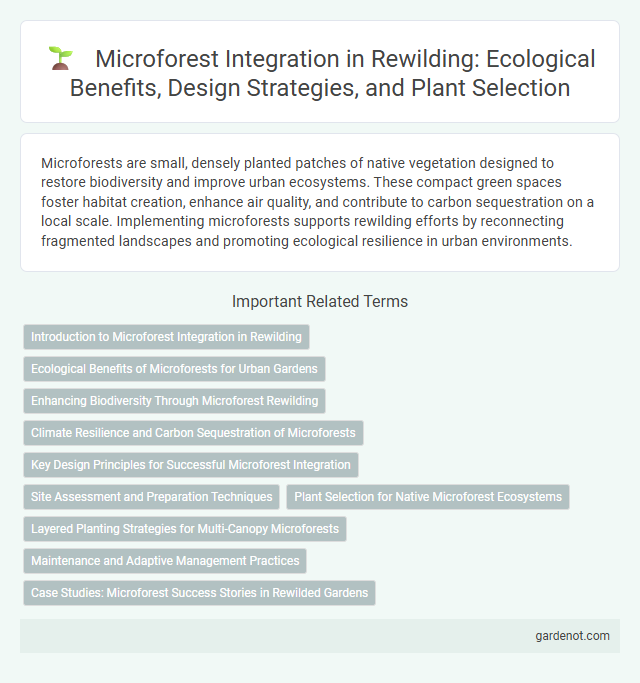Microforests are small, densely planted patches of native vegetation designed to restore biodiversity and improve urban ecosystems. These compact green spaces foster habitat creation, enhance air quality, and contribute to carbon sequestration on a local scale. Implementing microforests supports rewilding efforts by reconnecting fragmented landscapes and promoting ecological resilience in urban environments.
Introduction to Microforest Integration in Rewilding
Microforests play a pivotal role in rewilding by rapidly restoring biodiversity within compact urban or degraded landscapes. These dense, native-species clusters are designed to mimic natural forest ecosystems, enhancing habitat connectivity and supporting local wildlife populations. Integrating microforests in rewilding initiatives accelerates ecological recovery, improves air quality, and promotes soil health in fragmented environments.
Ecological Benefits of Microforests for Urban Gardens
Microforests enhance urban gardens by increasing biodiversity, providing habitat for native species, and improving air quality through carbon sequestration. These small, densely planted forests contribute to soil health by promoting nutrient cycling and moisture retention, creating a resilient ecosystem within limited urban spaces. Integrating microforests into city landscapes supports pollinators and mitigates urban heat island effects, fostering sustainable, thriving green environments.
Enhancing Biodiversity Through Microforest Rewilding
Microforest rewilding significantly enhances biodiversity by creating dense, native tree clusters that provide essential habitats for various species. These small-scale forests support pollinators, birds, and small mammals, promoting ecological connectivity within urban and rural landscapes. By restoring native flora, microforests improve soil health, increase carbon sequestration, and foster resilient ecosystems.
Climate Resilience and Carbon Sequestration of Microforests
Microforests enhance climate resilience by increasing biodiversity and improving soil health, which stabilizes local ecosystems against extreme weather events. These densely planted native trees accelerate carbon sequestration by capturing significant amounts of CO2 in their biomass and soil, contributing to urban carbon sinks. Studies show that microforests can store up to 10 times more carbon per unit area compared to traditional urban green spaces, making them critical tools for mitigating climate change.
Key Design Principles for Successful Microforest Integration
Microforests thrive when designed with native species diversity to enhance local biodiversity and ecosystem resilience. Prioritizing layered vegetation structures, including canopy, understory, and ground cover, maximizes habitat complexity and carbon sequestration. Strategic site selection ensures optimal soil conditions and water availability, supporting healthy growth and long-term sustainability.
Site Assessment and Preparation Techniques
Site assessment for microforest projects involves analyzing soil quality, moisture levels, and existing vegetation to ensure optimal growth conditions for native species. Preparation techniques include soil aeration, removal of invasive plants, and strategic placement of organic mulch to enhance soil fertility and water retention. Accurate evaluation of sunlight exposure and microclimate variations supports selecting appropriate plant species that boost biodiversity and ecosystem resilience.
Plant Selection for Native Microforest Ecosystems
Plant selection for native microforest ecosystems prioritizes indigenous tree and shrub species to enhance biodiversity and ecosystem resilience. Choosing fast-growing pioneer plants like alder or willow accelerates canopy development and soil enrichment by nitrogen fixation. Incorporating diverse understory flora such as native ferns, wildflowers, and grasses supports pollinators and establishes a balanced, self-sustaining microforest habitat.
Layered Planting Strategies for Multi-Canopy Microforests
Layered planting strategies in multi-canopy microforests maximize biodiversity by integrating diverse plant species across vertical strata, including ground covers, shrubs, understory trees, and canopy trees. This approach enhances ecosystem resilience, promotes habitat heterogeneity, and improves carbon sequestration through increased foliage density. Effective layering mimics natural forest succession, accelerating ecological restoration and supporting pollinators, birds, and soil microbiomes within rewilding projects.
Maintenance and Adaptive Management Practices
Microforest maintenance involves regular monitoring of soil health, moisture levels, and plant growth to ensure ecosystem stability and resilience in rewilding projects. Adaptive management practices include adjusting planting density, species composition, and invasive species control based on real-time ecological feedback to promote biodiversity and habitat quality. These dynamic strategies optimize carbon sequestration, microclimate regulation, and long-term sustainability of microforests in urban and degraded landscapes.
Case Studies: Microforest Success Stories in Rewilded Gardens
Microforest projects, like Japan's Satoyama Initiative and Mumbai's Miyawaki Forests, demonstrate rapid biodiversity recovery and carbon sequestration in urban rewilding efforts. Studies show these dense, native tree plantations foster habitat creation for pollinators, birds, and small mammals within 2-3 years. Success in rewilded gardens highlights microforests' role in enhancing ecological connectivity and climate resilience in cities worldwide.
Microforest Infographic

 gardenot.com
gardenot.com